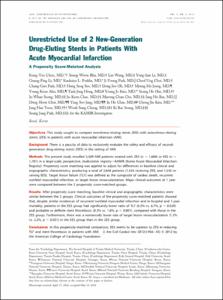KUMEL Repository
1. Journal Papers (연구논문)
1. School of Medicine (의과대학)
Dept. of Internal Medicine (내과학)
Unrestricted Use of 2 New-Generation Drug-Eluting Stents in Patients With Acute Myocardial Infarction A Propensity Score-Matched Analysis
- Keimyung Author(s)
- Hur, Seung Ho
- Department
- Dept. of Internal Medicine (내과학)
- Journal Title
- JACC: Cardiovascular Interventions
- Issued Date
- 2012
- Volume
- 5
- Issue
- 9
- Keyword
- acute myocardial infarction; everolimus-eluting stents; percutaneous coronary intervention; zotarolimus-eluting stents
- Abstract
- Objectives:
This study sought to compare everolimus-eluting stents (EES) with zotarolimus-eluting stents (ZES) in patients with acute myocardial infarction (AMI).
Background:
There is a paucity of data to exclusively evaluate the safety and efficacy of second-generation drug-eluting stents (DES) in the setting of AMI.
Methods:
The present study enrolled 3,309 AMI patients treated with ZES (n = 1,608) or EES (n = 1,701) in a large-scale, prospective, multicenter registry—KAMIR (Korea Acute Myocardial Infarction Registry). Propensity score matching was applied to adjust for differences in baseline clinical and angiographic characteristics, producing a total of 2,646 patients (1,343 receiving ZES, and 1,343 receiving EES). Target lesion failure (TLF) was defined as the composite of cardiac death, recurrent nonfatal myocardial infarction, or target lesion revascularization. Major clinical outcomes at 1 year were compared between the 2 propensity score-matched groups.
Results:
After propensity score matching, baseline clinical and angiographic characteristics were similar between the 2 groups. Clinical outcomes of the propensity score-matched patients showed that, despite similar incidences of recurrent nonfatal myocardial infarction and in-hospital and 1-year mortality, patients in the EES group had significantly lower rates of TLF (6.5% vs. 8.7%, p = 0.029) and probable or definite stent thrombosis (0.3% vs. 1.6%, p < 0.001), compared with those in the ZES group. Furthermore, there was a numerically lower rate of target lesion revascularization (1.2% vs. 2.2%, p = 0.051) in the EES group than in the ZES group.
Conclusions:
In this propensity-matched comparison, EES seems to be superior to ZES in reducing TLF and stent thrombosis in patients with AMI.
- Keimyung Author(s)(Kor)
- 허승호
- Publisher
- School of Medicine
- Citation
- Kang-Yin Chen et al. (2012). Unrestricted Use of 2 New-Generation Drug-Eluting Stents in Patients With Acute Myocardial Infarction A Propensity Score-Matched Analysis. JACC: Cardiovascular Interventions, 5(9), 936–945. doi: 10.1016/j.jcin.2012.05.009
- Type
- Article
- ISSN
- 1936-8798
- Appears in Collections:
- 1. School of Medicine (의과대학) > Dept. of Internal Medicine (내과학)
- 파일 목록
-
-
Download
 oak-aaa-2646.pdf
기타 데이터 / 1.16 MB / Adobe PDF
oak-aaa-2646.pdf
기타 데이터 / 1.16 MB / Adobe PDF
-
Items in Repository are protected by copyright, with all rights reserved, unless otherwise indicated.